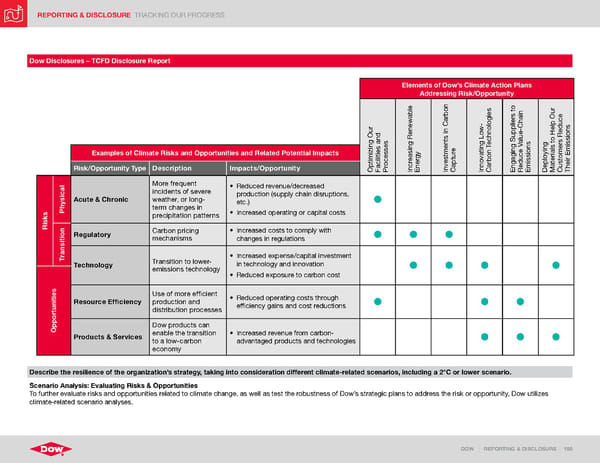REPORTING & DISCLOSURE TRACKING OUR PROGRESS DOW | REPORTING & DISCLOSURE | 188 Dow Disclosures – TCFD Disclosure Report Elements of Dow’s Climate Action Plans Addressing Risk/Opportunity Optimizing Our Facilities and Processes Increasing Renewable Energy Investments in Carbon Capture Innovating Low- Carbon Technologies Engaging Suppliers to Reduce Value-Chain Emissions Deploying Materials to Help Our Customers Reduce Their Emissions Examples of Climate Risks and Opportunities and Related Potential Impacts Risk/Opportunity Type Description Impacts/Opportunity Risks Physical Acute & Chronic More frequent incidents of severe weather, or long- term changes in precipitation patterns • Reduced revenue/decreased production (supply chain disruptions, etc.) • Increased operating or capital costs Transition Regulatory Carbon pricing mechanisms • Increased costs to comply with changes in regulations Technology Transition to lower- emissions technology • Increased expense/capital investment in technology and innovation • Reduced exposure to carbon cost Opportunities Resource Efficiency Use of more efficient production and distribution processes • Reduced operating costs through efficiency gains and cost reductions Products & Services Dow products can enable the transition to a low-carbon economy • Increased revenue from carbon- advantaged products and technologies Describe the resilience of the organization’s strategy, taking into consideration different climate-related scenarios, including a 2°C or lower scenario. Scenario Analysis: Evaluating Risks & Opportunities To further evaluate risks and opportunities related to climate change, as well as test the robustness of Dow’s strategic plans to address the risk or opportunity, Dow utilizes climate-related scenario analyses.
 ESG Report | Dow Page 187 Page 189
ESG Report | Dow Page 187 Page 189